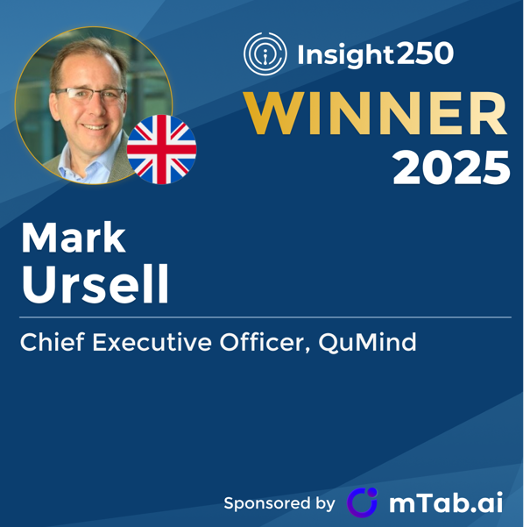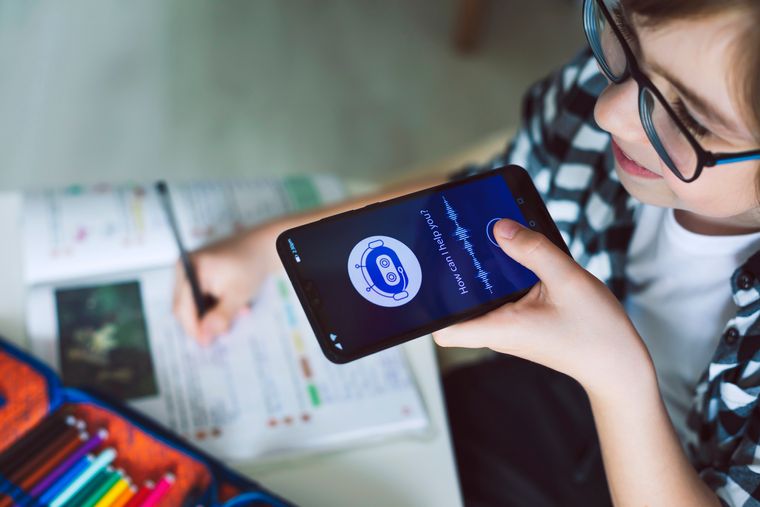The Emerging Impact of Digital Twins
With technology advancing at an incredible pace and the value of insights ever increasing, I sat down with Insight250 Winner Mark Ursell.

Article series
Insight250
- The importance of business sense in research
- The role of humour in effective leadership
- The importance of ethics
- The importance of disruption in innovation and leadership
- The importance of Disruption in Innovation and Leadership Part 2
- The importance of Diversity & Inclusion
- The impact of colour
- Communicating insight with impact
- Insights on leadership, culture and polling
- The evolution of electric vehicles
- 2022 Top tips (part 1)
- 2022 Top tips (part 2)
- Maximising the potential of data
- The importance of flexible working
- Winners
- The importance of advanced analytics
- Judges for the 2022 Insight250 Awards announced
- The evolution from social listening to digital intelligence
- The Judges' Perspective
- The judge's perspective - part 2
- Insight Climate Collective
- Insights technology
- Understanding employee ownership
- Global insight perspectives
- Top Tips from our Leaders and Innovators
- The Evolution of Insights in the Food & Beverage Market
- The Evolution of Insights in CPG
- Neural Mechanisms Behind Consumer Decision-Making
- Celebrating and Elevating the Insights Industry
- The State of the Insights Industry
- Opportunities, challenges and threats that AI presents
- 2024 Insight250 Winners Announcement
- Connecting Brands and Consumers Through Insights
- The Importance of Human Insight and Attention
- The Elevating Role of Insights with Technology Innovation
- Haleon’s Insight Expert on Consumer Healthcare
- Insight from the Insight250: How AI is Impacting Qualitative Research
- How AI Tech is Doing the ‘Heavy Lifting’ for Insights
- Reviewing the top tips for 2025
- Google's Sarah Ashley on AI and revolutionising insights - Insights from the Insight250
- Beyond BI: The Future of Decision Intelligence for Insight Professionals
- The Advancement & Impact of Insights - An Insight250 Winners Series perspective with David Smith
- International Jury for the 2025 Insight250 Awards Announced
- Newly elected President, Anne-Sophie, on Revolutionizing the Impact of Insights
- Haleon's Litthya Baez on Enhancing Healthcare with Insights - Insight250 Winners Series
- Understanding the Insights of Consumer Decisions
- Moving Beyond Dashboards to Deliver Decisions with AI
- How AI is Transforming Insights
- How AI is Transforming Insights
- Five Years of Insight250: Elevating the Insight Industry
The Insight250 spotlights and celebrates 250 of the world’s premier leaders and innovators in market research, consumer insights, and data-driven marketing. The awards have created renewed excitement across the industry whilst strengthening the connectivity of the market research community. Winners of the 2025 Insight250 were announced this past September - you can see the full list of Winners at Insight250.com.
With so many exceptional professionals named to the Insight250, we regularly tap into their expertise and unique perspectives across various topics. This regular series does just that: inquiring about the expert perspectives of many of these individuals in a series of short topical features.
With technology advancing at an incredible pace and the value of insights ever increasing, I sat down with Insight250 Winner Mark Ursell. Mark is CEO of QuMind which has recently been acquired by Largo.ai. Mark founded QuMind in 1999 and is EVP of Largo. His vast experience in online insights and innovation helps power the delivery of new insight tech solutions for the organisation and its portfolio.
Crispin: What are digital twins?
MU: Technology is re-shaping the market research landscape in multiple ways, and at the forefront of this change is the concept of the digital twin. The digital twin is transforming how agencies and brands can generate insight to make faster strategic decisions. In essence, they are virtual respondents that replicate real consumer behaviour and typically can take part in surveys, focus groups, and one-to-one in-depth interviews.
MU: Are digital twins always the same?
MU: Two particular methods are emerging that create these twins, Simulated, which are built from survey data gathered from real respondents, or synthetic, which are built using large language models (LLMs), and entirely from AI-generated responses.
Both approaches promise new possibilities, but they also differ in fundamental ways that matter deeply for insight professionals.
Crispin: How are simulated twins created?
MU: The foundation of any meaningful insight remains the same: data gathered from real people, and this is the basis of simulated digital twins, which are built from survey respondent data from a customised questionnaire. From this dataset, an algorithm creates the twin. The benefit of this approach is that the twins are created using observed relationships within validated datasets, which typically cover demographics, media consumption, lifestyle values, purchasing habits, and much more.
Because the twins are anchored in real-world data, they deliver high levels of accuracy. The twins more closely reflect how people actually think and behave, and this grounding makes them more suitable for measurement and decision-making.
To date, evidence demonstrates over 90% accuracy of simulated digital twins compared to real human beings, which is very encouraging. Simulated twins are normally re-created after a year, to keep them relevant in an ever-changing world, but can be sooner with more dynamic markets.
Crispin: How are synthetic digital twins created?
MU: In parallel, synthetic digital twins are emerging as a powerful complement.. Synthetic twins are created using large language models, creating virtual consumers with specific demographic, attitudinal, or behavioural traits.
The advantages are that the setup is much quicker, and synthetic twins can generate insights almost instantly. In addition, because LLMs have access to such a vast amount of data, they are used for niche audiences that are hard to create simulated audiences from real people. Accuracy, therefore, does vary, but good quality synthetic twins should be between 60 to 70% accurate, and even up to 80% in less niche markets.
Crispin: When and where should digital twins be used?
MU: Our preferred approach, or first port of call, is to use simulated twins as the human data at recruitment, providing the anchor and the empirically validated foundation that ensures truth and accuracy. If the audience is too niche or costly to set up, then synthetic twins are used, but then there is a trade-off with accuracy.
To date, we have found that where digital twins, however generated, work best is at the foundation stage in NPD, enabling rapid scenario modelling, creative ideation, and exploration at scale. In addition, we have used twins to simulate emerging segments and explore “what if” scenarios that would be impossible to test in live research.
The core areas we would recommend are;
Test new concepts instantly and refine with follow-up with the digital respondents.
Explore future behaviours or markets that haven’t yet been measured.
Simulate “what if” scenarios using AI-generated extensions of your ideas and evolve the concept, and constantly repeat refined tests with the same audience at scale.
Crispin: What are the pros of digital twins?
MU: At present, digital twins can transform how we do concept development, idea testing, or market simulation with the capability to generate thousands of realistic responses in seconds. In addition, twins offer the ability to go back to the same twins to refine and retest at scale, and it is this that is really game-changing.
Digital twins, therefore, will enhance, not replace, respondent data, acting as an exploratory layer designed to give brands a deeper, faster, and more predictive understanding of their consumers, acting alongside current methods with real humans.
Crispin: What are the cons of digital twins?
MU: The creation of simulated twins comes with real-world data collection challenges. Although fieldwork can be quick, there is an initial setup phase to manage, and profiling surveys can be lengthy. Twins can be rejected if they respond differently to humans, which can lengthen the time from setup to a robust sample of twins. Consumer attitudes also evolve quickly, meaning data must be refreshed regularly to remain relevant, but we have found that for mainstream brands, once a year is sufficient. In more dynamic markets, these can be done more frequently.
When it comes to synthetic data, the main issue is that the data used to create the twins is not empirical and therefore not as accurate. In addition, it is very hard to tell the provenance of data and the built-in biases that sit behind each twin. As a result, synthetic twins generate responses that sound human, but they are shaped by patterns in text data, not by measured human experience. Without calibration, there’s a risk of false realism and insights that appear plausible but aren’t statistically grounded.
For insight professionals, the mission remains unchanged, which is to help key decision-makers within brands make confident decisions with robust data and concise storytelling. There is no doubt that digital twins will be part of the ‘tool kit’ to get to this point, but I cannot see a future where this overtakes feedback from real humans, as we cannot override the desire of human beings wanting to interact and understand each other.
The future of insight won’t be defined by choosing between real, simulated or synthetic data, but by how intelligently we combine them in the right place and the right time.
Top Tip
MU: My one big tip for insight professionals going forward is the need to seriously elevate the focus on the provenance of data and ensuring proper guardrails are in place to make sure the data is of high quality and accuracy, so key decision makers can trust the data to make successful decisions that drive business success. This trust will be the biggest challenge for the use of data derived from digital twins going forward.
Crispin: Mark, thank you for sharing the unique insight you have on the realm of digital twins. It’s been fantastic to hear your thoughts on this innovative research approach and where you see it evolving in the future.

Crispin Beale
Chairman at QuMind, CEO at Insight250, Senior Strategic Advisor at mTab, CEO at IDXCrispin Beale is a marketing, data and customer experience expert. Crispin spent over a decade on the Executive Management Board of Chime Communications as Group CEO of leading brands such as Opinion Leader, Brand Democracy, Facts International and Watermelon. Prior to this Crispin held senior marketing and insight roles at BT, Royal Mail Group and Dixons. Crispin originally qualified as a chartered accountant and moved into management consultancy with Coopers & Lybrand (PwC). Crispin has been a Board Director (and Chairman) of the MRS for nearly 20 years and UK ESOMAR Representative for c15 years. As well as being CEO of Insight250, Crispin is currently Worldwide CEO of Digital Communications Solution Agency, IDX. Crispin is also the Senior Strategic Advisor at mTab and the Chairman of QuMind and spent 4 years as Group President of Behaviorally where he was responsibile for the client & commercial teams globally. Crispin is a passionate advocate for blending human intelligence and technology to deliver innovation and leadership across organisations.
Article series
Insight250
- The importance of business sense in research
- The role of humour in effective leadership
- The importance of ethics
- The importance of disruption in innovation and leadership
- The importance of Disruption in Innovation and Leadership Part 2
- The importance of Diversity & Inclusion
- The impact of colour
- Communicating insight with impact
- Insights on leadership, culture and polling
- The evolution of electric vehicles
- 2022 Top tips (part 1)
- 2022 Top tips (part 2)
- Maximising the potential of data
- The importance of flexible working
- Winners
- The importance of advanced analytics
- Judges for the 2022 Insight250 Awards announced
- The evolution from social listening to digital intelligence
- The Judges' Perspective
- The judge's perspective - part 2
- Insight Climate Collective
- Insights technology
- Understanding employee ownership
- Global insight perspectives
- Top Tips from our Leaders and Innovators
- The Evolution of Insights in the Food & Beverage Market
- The Evolution of Insights in CPG
- Neural Mechanisms Behind Consumer Decision-Making
- Celebrating and Elevating the Insights Industry
- The State of the Insights Industry
- Opportunities, challenges and threats that AI presents
- 2024 Insight250 Winners Announcement
- Connecting Brands and Consumers Through Insights
- The Importance of Human Insight and Attention
- The Elevating Role of Insights with Technology Innovation
- Haleon’s Insight Expert on Consumer Healthcare
- Insight from the Insight250: How AI is Impacting Qualitative Research
- How AI Tech is Doing the ‘Heavy Lifting’ for Insights
- Reviewing the top tips for 2025
- Google's Sarah Ashley on AI and revolutionising insights - Insights from the Insight250
- Beyond BI: The Future of Decision Intelligence for Insight Professionals
- The Advancement & Impact of Insights - An Insight250 Winners Series perspective with David Smith
- International Jury for the 2025 Insight250 Awards Announced
- Newly elected President, Anne-Sophie, on Revolutionizing the Impact of Insights
- Haleon's Litthya Baez on Enhancing Healthcare with Insights - Insight250 Winners Series
- Understanding the Insights of Consumer Decisions
- Moving Beyond Dashboards to Deliver Decisions with AI
- How AI is Transforming Insights
- How AI is Transforming Insights
- Five Years of Insight250: Elevating the Insight Industry


